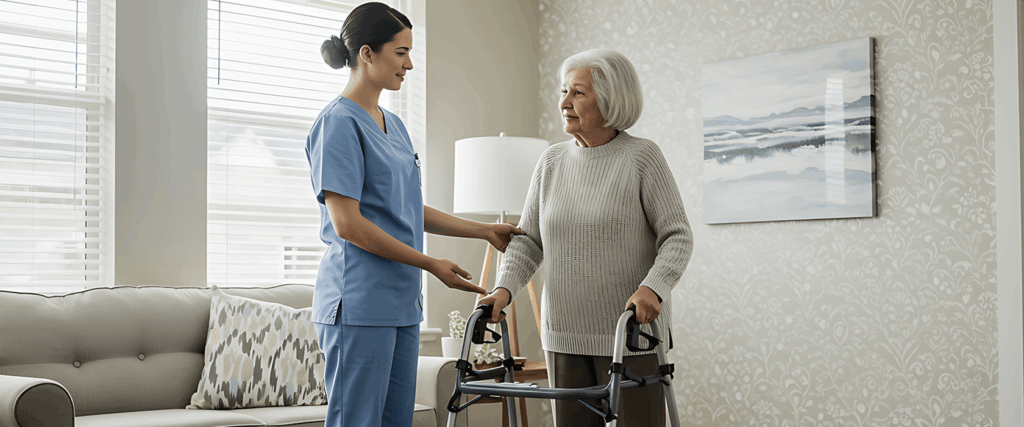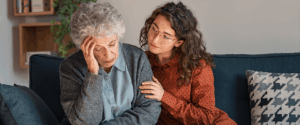
Fall Prevention for Seniors: Your Complete Guide to Safety and Independence
Key Takeaways
- Falls affect 1 in 4 seniors every year, but most falls are preventable with proper planning and safety measures
- Creating a safe home environment combined with staying physically active significantly reduces fall risk
- Regular health check-ups and medication reviews play crucial roles in fall prevention strategies
- Modern technology and wellness coaching can provide additional support for maintaining independence
- Small, proactive changes in daily routines can make a major difference in preventing serious falls
Maintaining independence while aging safely at home is a priority for millions of seniors and their families. Falls represent one of the most serious threats to this independence, but the good news is that most falls can be prevented. Understanding how to prevent falls and implementing the right safety measures can help seniors continue living confidently in their own homes.
Understanding Fall Prevention in the Elderly
Fall prevention in the elderly has become increasingly important as recent data show that 14 million Americans ages 65 and older fall each year. While not all falls result in injury, about 37% of those who fall require medical treatment or experience limited activity and mobility following the fall. These statistics highlight why proactive fall prevention strategies are essential for maintaining senior health and independence.
Fall prevention in the elderly goes beyond just avoiding accidents. It encompasses a comprehensive approach that includes physical fitness, home safety modifications, regular health monitoring, and lifestyle adjustments. When seniors and their caregivers work together to address multiple risk factors, they create a strong foundation for continued independence and peace of mind.
The most effective fall prevention programs recognize that each senior’s situation is unique. Factors such as medical history, current health conditions, living environment, and personal preferences all play important roles in developing an effective prevention strategy.
Common Risk Factors That Lead to Falls

Understanding what causes falls is the first step in prevention. Many seniors experience multiple risk factors, and the combination of these factors increases fall risk significantly. Age-related changes affect everyone differently, but there are a number of common contributors to be aware of.
- Physical changes such as decreased muscle strength, reduced flexibility, and changes in balance and coordination naturally occur with aging.
- Vision and hearing changes can also affect general awareness and reaction times.
- Medical conditions like diabetes, heart disease, arthritis, or thyroid problems can impact balance and mobility.
- Medications often play a role in fall risk. Some prescription drugs can cause dizziness, drowsiness, or drops in blood pressure that increase the likelihood of falling. Pain medications, sleep aids, and even some blood pressure medications may have these effects.
- Environmental factors in the home and community create additional challenges. Poor lighting, loose rugs, clutter, uneven surfaces, and missing handrails all contribute to fall risk. Even seemingly minor hazards can become major safety concerns when combined with other risk factors.
How to Prevent Falls: Essential Safety Strategies
Learning how to prevent falls effectively requires an approach that addresses both personal health factors and environmental safety. The most successful prevention strategies combine several key elements that work together to reduce risk.
Staying physically active is one of the most effective tools for preventing falls. Regular exercise helps maintain muscle strength, flexibility, balance, and coordination. Activities like walking, swimming, tai chi, and yoga are particularly beneficial. Even gentle exercises performed while seated can help maintain strength and flexibility.
Balance training deserves special attention in any fall prevention program. Simple exercises like standing on one foot, heel-to-toe walking, or practicing getting up from a chair without using your hands can significantly improve stability. Many community centers and senior centers offer balance-focused exercise classes specifically designed for older adults.
Regular health check-ups also play a crucial role in fall prevention. During these visits, healthcare providers can review medications for side effects that might increase fall risk, check vision and hearing, assess balance and gait, and address any health conditions that could contribute to falls.
Sleep quality significantly impacts fall risk, too. Poor sleep can affect reaction time, balance, and cognitive function. Creating a comfortable sleep environment, maintaining regular sleep schedules, and addressing any sleep disorders can help reduce the risk of falls.
Safe Tips to Prevent Falls at Home

The home environment presents both the greatest opportunity for fall prevention and the most common location where falls occur. Taking steps to prevent falls at home can dramatically reduce risk while allowing seniors to maintain their independence and comfort.
Lighting improvements make an immediate difference in home safety. Ensure all areas of the home are well-lit, especially stairways, hallways, and bathrooms. Install nightlights along pathways from bedrooms to bathrooms. Consider motion-activated lights for added convenience and safety during nighttime movement.
Bathroom modifications often provide the highest return on safety investment. Install grab bars near toilets and in shower areas, use non-slip mats in tubs and showers, consider a shower chair or bench for safer bathing, and ensure the bathroom floor stays dry and free of water puddles.
Floor safety requires ongoing attention throughout the home. Remove or secure loose rugs and mats, keep walkways clear of clutter, electrical cords, and furniture, ensure carpets are in good repair without loose edges, and clean up spills immediately to prevent slippery surfaces.
Stair safety modifications can prevent some of the most serious falls. Install sturdy handrails on both sides of stairways, ensure steps are in good repair with non-slip surfaces, improve lighting at the top and bottom of stairs, and consider marking the edges of steps with contrasting tape for better visibility.
Storage and organization changes reduce the need for risky reaching or climbing. Keep frequently used items at waist level, use reaching tools or long-handled shoe horns to avoid bending, store heavy items in lower cabinets, and avoid using step stools or ladders when possible.
The Role of Technology in Modern Fall Prevention
Technology has revolutionized fall prevention approaches, offering new ways to monitor health, detect emergencies, and support independent living. Modern fall prevention strategies increasingly incorporate smart devices and monitoring systems that provide both seniors and their caregivers with valuable insights and peace of mind.
Wearable devices can monitor daily activity levels, sleep patterns, and even detect when falls occur. Some devices automatically alert emergency contacts or medical professionals if a fall is detected. These technologies help seniors maintain independence while ensuring help is available when needed.
Smart home systems can enhance safety through automated lighting, medication reminders, and environmental monitoring. Some systems can track movement patterns and alert caregivers to changes that might indicate increased fall risk.
Telehealth services make it easier for seniors to stay connected with healthcare providers for regular check-ups and medication management. This ongoing monitoring helps identify and address fall risk factors before they lead to accidents.
Building a Fall Prevention Plan

Creating an effective fall prevention plan requires collaboration between seniors, family members, caregivers, and healthcare professionals. The most successful plans address multiple risk factors while respecting the senior’s desire for independence and quality of life.
A wellness coach can play a valuable role in developing and implementing a personalized fall prevention plan. These professionals work with seniors to assess current risk factors, set realistic safety goals, and create strategies for maintaining motivation and consistency.
Family involvement strengthens fall prevention efforts significantly. When family members understand the importance of fall prevention and know how to help, seniors receive better support for maintaining their safety strategies. This might include help with home modifications, transportation to exercise classes, or assistance with regular health check-ups.
Supporting Independence Through Proactive Care
The ultimate goal of fall prevention extends beyond simply avoiding accidents. Effective prevention strategies help seniors maintain their independence, confidence, and quality of life while aging safely in their preferred environment.
ClearWellness understands that each senior’s journey is unique; that’s why our Certified Health and Wellness Coaches work collaboratively with seniors to develop personalized wellness plans that address fall prevention as part of a comprehensive approach to healthy aging.
These plans can include activity goals that focus on strength and balance, sleep improvement strategies that enhance mental clarity and reduce nighttime fall risk, and noninvasive monitoring through technology that helps identify changes in well-being before they become safety concerns.
The combination of professional guidance, smart technology monitoring, and personalized care plans creates a powerful support system that helps seniors feel confident about their ability to live independently while knowing that help is available when needed.
Taking the Next Steps

Fall prevention works best when it becomes part of a senior’s daily routine rather than an occasional concern. Start with small changes that feel manageable and build confidence. Simple modifications like improving lighting or removing a loose rug can provide immediate safety benefits, while more comprehensive changes like starting an exercise program develop over time.
Remember that fall prevention is an ongoing process, not a one-time fix. Regular assessment and adjustment of safety strategies ensure they remain effective as circumstances change. Investment in fall prevention pays dividends in maintained independence, reduced healthcare costs, and improved quality of life.
Frequently Asked Questions
What are the most important home modifications for preventing falls?
The most impactful home modifications include improving lighting throughout the home, installing grab bars in bathrooms, removing tripping hazards like loose rugs and clutter, and ensuring stairways have sturdy handrails. These modifications address the most common environmental causes of falls and can often be implemented relatively easily and affordably.
How often should seniors have their vision and hearing checked for fall prevention?
Seniors should have comprehensive eye exams annually, or more frequently if they have conditions like diabetes or glaucoma. Hearing should be checked at least every two years or whenever changes in hearing are noticed. Both vision and hearing changes can significantly impact balance and spatial awareness, making regular check-ups crucial for fall prevention.
What types of exercise are best for fall prevention in seniors?
The most effective exercises for fall prevention focus on balance, strength, and flexibility. Tai chi, yoga, water aerobics, and walking are excellent choices. Balance-specific exercises like standing on one foot or heel-to-toe walking are particularly beneficial. The key is choosing activities that are enjoyable and appropriate for individual fitness levels to encourage consistency.
How can family members help support fall prevention efforts?
Family members can help by assisting with home safety assessments, providing transportation to exercise classes or medical appointments, helping with medication management, and staying informed about fall prevention strategies. Regular communication about any concerns or changes in mobility helps ensure safety strategies remain effective.
When should I consider professional help for fall prevention?
Consider professional help if you’ve experienced any falls, have concerns about balance or mobility, are taking multiple medications that might affect stability, or feel anxious about falling. Healthcare providers, physical therapists, occupational therapists, and wellness coaches can all provide valuable guidance for developing comprehensive fall prevention strategies.
You Might Also Like

Understanding Alzheimer’s: Building Awareness and Supporting Cognitive Health
